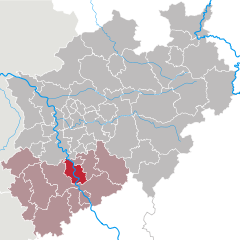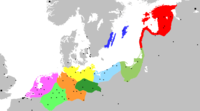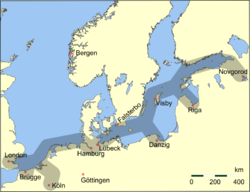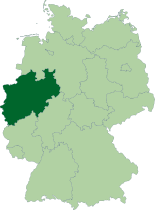Cologne
| Köln Cologne |
||
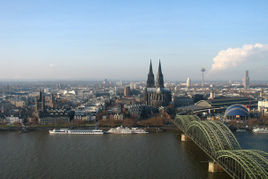 |
||
|
 |
|
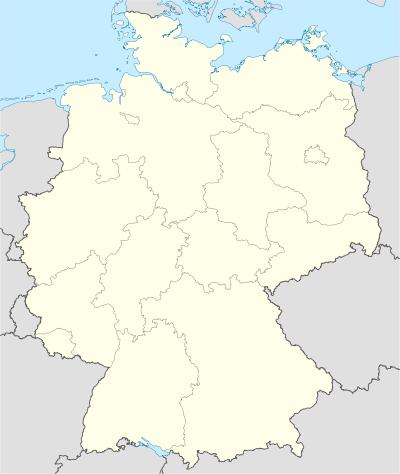 Cologne
|
||
|
Cologne within North Rhine-Westphalia
|
||
|---|---|---|
| Coordinates | ||
| Administration | ||
| Country | Germany | |
| State | North Rhine-Westphalia | |
| Admin. region | Cologne | |
| District | Urban district | |
| Lord Mayor | Jürgen Roters (SPD) | |
| Basic statistics | ||
| Area | 405.15 km2 (156.43 sq mi) | |
| Elevation | 37 m (121 ft) | |
| Population | 998,105 (31 December 2009)[1] | |
| - Density | 2,464 /km2 (6,381 /sq mi) | |
| Founded | 38 BC | |
| Other information | ||
| Time zone | CET/CEST (UTC+1/+2) | |
| Licence plate | K | |
| Postal codes | 50441–51149 | |
| Area codes | 0221, 02203 (Porz) | |
| Website | www.stadt-koeln.de | |
Cologne (German: Köln, pronounced [ˈkœln] (![]() listen); Kölsch dialect: Kölle [ˈkœɫə]) is Germany's fourth-largest city (after Berlin, Hamburg and Munich), and is the largest city both in the German Federal State of North Rhine-Westphalia and within the Rhine-Ruhr Metropolitan Area, one of the major European metropolitan areas with more than ten million inhabitants. It is one of the oldest cities in Germany, having been founded by the Ubii in the year 38 BC. The name is derived from that of the Roman settlement, Colonia Claudia Ara Agrippinensium.
listen); Kölsch dialect: Kölle [ˈkœɫə]) is Germany's fourth-largest city (after Berlin, Hamburg and Munich), and is the largest city both in the German Federal State of North Rhine-Westphalia and within the Rhine-Ruhr Metropolitan Area, one of the major European metropolitan areas with more than ten million inhabitants. It is one of the oldest cities in Germany, having been founded by the Ubii in the year 38 BC. The name is derived from that of the Roman settlement, Colonia Claudia Ara Agrippinensium.
Cologne lies on the River Rhine. The city's famous Cologne Cathedral (Kölner Dom) is the seat of the Catholic Archbishop of Cologne. The University of Cologne (Universität zu Köln) is one of Europe's oldest universities.
Cologne is a major cultural center of the Rhineland and has a vibrant arts scene. Cologne is home to more than 30 museums and hundreds of galleries. Exhibitions range from local ancient Roman archeological sites to contemporary graphics and sculpture. The Cologne Trade Fair hosts a number of trade shows such as Art Cologne, imm Cologne International Furniture Fair and the Photokina. Cologne is also well-known for its celebration of Cologne Carnival, the annual reggae summerjam, and Cologne Gay Pride.
Within Germany, Cologne is known as an important media center. Several radio and television stations, including Westdeutscher Rundfunk (WDR), RTL and VOX, have their headquarters in the city. Both Pro7 and Sat.1 produce TV shows in Cologne as well. Further, the city hosts the Cologne Comedy Festival, which is considered to be the largest comedy festival in mainland Europe.[2]
Contents |
Demographics
Cologne is the fourth-largest city in Germany in terms of inhabitants after Berlin, Hamburg and Munich. As of 31 December 2009, there were officially 998,105 residents.[3] Cologne is the center of the Cologne/Bonn Region with around 3 million inhabitants (including the neighboring cities of Bonn, Hürth, Leverkusen, and Bergisch Gladbach).
According to local statistics, in 2006 the population density in the city was 2,528 inhabitants per square kilometer. 31.4 percent of the population has migrated there, and 17.2 percent of Cologne's population is non-German. The largest group, comprising 6.3 percent of the total population, is Turkish.[4] As of September 2007, there are about 120,000 Muslims living in Cologne, mostly of Turkish origin.[5]
In the city the population was spread out with 15.5% under the age of 18, 67.0% from 18 to 64 and 17.4% who were 65 years of age or older.[6]
Government
Cologne is part of the Cologne/Bonn Region and incorporated as an independent city (Kreisfreie Stadt) under the Gemeindeordnung Nordrhein-Westfalen (GO NRW) (Municipality Code of North Rhine-Westphalia). The city's administration is headed by a mayor (Oberbürgermeister) and three deputy mayors.
Districts
Cologne is subdivided into 9 districts (Stadtbezirke) and 86 city parts (Stadtteile):
|
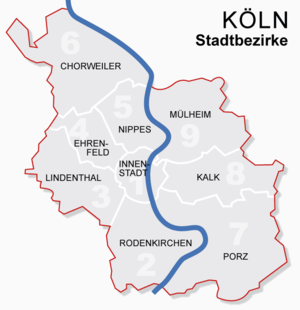 |
|
Geography
Climate
Cologne is one of the warmest cities in Germany. It has a temperate–oceanic climate with relatively mild winters and warm summers. Its average annual temperature is 10 °C (50 °F): 14.5 °C (58 °F) during the day and 5.5 °C (42 °F) at night.
| Climate data for Cologne | |||||||||||||
|---|---|---|---|---|---|---|---|---|---|---|---|---|---|
| Month | Jan | Feb | Mar | Apr | May | Jun | Jul | Aug | Sep | Oct | Nov | Dec | Year |
| Average high °C (°F) | 5.2 (41.4) |
6.6 (43.9) |
10.5 (50.9) |
14.2 (57.6) |
19.0 (66.2) |
21.3 (70.3) |
23.7 (74.7) |
23.7 (74.7) |
19.6 (67.3) |
14.6 (58.3) |
9.0 (48.2) |
6.2 (43.2) |
14.5 (58.1) |
| Daily mean °C (°F) | 2.3 (36.1) |
2.9 (37.2) |
6.1 (43) |
8.9 (48) |
13.4 (56.1) |
16.0 (60.8) |
18.3 (64.9) |
18.0 (64.4) |
14.6 (58.3) |
10.4 (50.7) |
5.8 (42.4) |
3.4 (38.1) |
10.0 (50) |
| Average low °C (°F) | -0.7 (30.7) |
-0.9 (30.4) |
1.7 (35.1) |
3.6 (38.5) |
7.7 (45.9) |
10.7 (51.3) |
12.8 (55) |
12.3 (54.1) |
9.6 (49.3) |
6.2 (43.2) |
2.5 (36.5) |
0.6 (33.1) |
5.5 (41.9) |
| Precipitation mm (inches) | 60.4 (2.378) |
46.6 (1.835) |
62.5 (2.461) |
50.5 (1.988) |
72.4 (2.85) |
87.6 (3.449) |
86.0 (3.386) |
65.3 (2.571) |
69.3 (2.728) |
61.7 (2.429) |
63.2 (2.488) |
70.7 (2.783) |
796.2 (31.346) |
| Avg. precipitation days | 11.9 | 9.3 | 12.5 | 10.2 | 10.4 | 11.6 | 11.2 | 9.4 | 10.7 | 10.5 | 11.9 | 12.9 | 120.9 |
| Source: World Meteorological Organization (UN)[7] | |||||||||||||
Flood protection


Cologne is regularly affected by flooding from the Rhine and is considered the most flood-prone European city.[8] A city agency (Stadtentwässerungsbetriebe Köln[9]) manages an extensive flood control system which includes both permanent and mobile flood walls, protection from rising waters for buildings close to the river banks, monitoring and forecasting systems, pumping stations and programs to create or protect floodplains and river embankments.[8][10][11] The system was redesigned after a 1993 flood which resulted in heavy damages.[8]
History
Roman Cologne
The first urban settlement on the grounds of what today is the center of Cologne was Oppidum Ubiorum, which was founded in 38 BC by the Ubii, a Germanic tribe. Cologne became acknowledged as a city by the Romans in 50 AD by the name of Colonia Claudia Ara Agrippinensium. Considerable Roman remains can be found in contemporary Cologne, especially near the wharf area, where a notable discovery of a 1900 year old Roman boat was made in late 2007.[12] From 260 to 271 Cologne was the capital of the Gallic Empire under Postumus, Marius and Victorinus. In 310 under Constantine a bridge was built over the Rhine at Cologne.
Maternus, who was elected as bishop in 313, was the first known bishop of Cologne. The city was the capital of a Roman province until occupied by the Franks in 459. In 785, Cologne became the seat of an archbishopric.
Middle Ages
During the time of the Holy Roman Empire in the Middle Ages, the Archbishop of Cologne was one of the seven prince-electors and one of the three ecclesiastical electors. The archbishops had ruled large temporal domains but in 1288 Sigfried II von Westerburg was defeated in the Battle of Worringen and forced into exile at Bonn.
Cologne's location on the river Rhine placed it at the intersection of the major trade routes between east and west and was the basis of Cologne's growth. Cologne was a member of the Hanseatic League and became a Free Imperial City in 1475. Interestingly the archbishop nevertheless preserved the right of capital punishment. Thus, the municipal council (though in strict political opposition towards the archbishop) depended upon him in all matters concerning criminal jurisdiction. This included torture, which sentence was only allowed to be handed down by the episcopal judge, the so-called "Greve". This legal situation lasted until the French conquest of Cologne.
Besides its economic and political significance Cologne also became an outstanding centre of medieval pilgrimage, when Cologne's Archbishop Rainald of Dassel gave the relics of the Three Wise Men to Cologne's cathedral in 1164 (after they in fact had been captured from Milan). Besides the three magi Cologne preserves the relics of Saint Ursula and Albertus Magnus.
The economic structures of medieval and early modern Cologne were characterized by the city's status as a major harbor and transport hub upon the Rhine. Craftsmanship was organized by self-administering guilds, some of which were exclusive to women.

As a free city Cologne was a sovereign state within the Holy Roman Empire and as such had the right (and obligation) of maintaining its own military force. Wearing a red uniform these troops were known as the Rote Funken (red sparks). These soldiers were part of the Army of the Holy Roman Empire ("Reichskontingent") and fought in the wars of the 17th and 18th century, including the wars against revolutionary France, when the small force almost completely perished in combat. The tradition of these troops is preserved as a military persiflage by Cologne's most outstanding carnival society, the Rote Funken.[13]
The free city of Cologne must not be confused with the Archbishopric of Cologne which was a state of its own within the Holy Roman Empire. Since the second half of the 16th century the archbishops were taken from the Bavarian dynasty Wittelsbach. Due to the free status of Cologne, the archbishops usually were not allowed to enter the city. Thus they took residence in Bonn and later in Brühl on Rhine. As members of an influential and powerful family and supported by their outstanding status as electors, the archbishops of Cologne repeatedly challenged and threatened the free status of Cologne during the 17th and 18th century, resulting in complicated affairs, which were handled by diplomatic means and propaganda as well as by the supreme courts of the Holy Roman Empire.
19th and 20th century
Cologne lost its status as a free city during the French period. According to the Peace Treaty of Lunéville (1801) all the territories of the Holy Roman Empire on the left bank of the Rhine were officially incorporated into the French Republic (which already had occupied Cologne in 1798). Thus, this region later became part of Napoleon's Empire. Cologne was part of the French Département Roer (named after the River Roer, German: Rur) with Aachen (Aix-la-Chapelle) as its capital. The French modernized public life, for example by introducing the Napoleonic code and removing the old elites from power. The Napoleonic code remained in use on the left bank of the Rhine until 1900, when a unified civil code (the Bürgerliches Gesetzbuch) was introduced in the German Empire. In 1815, at the Congress of Vienna, Cologne was made part of the Kingdom of Prussia, first in the Jülich-Cleves-Berg province and then the Rhine province.
The permanent tensions between the Roman Catholic Rhineland and the overwhelmingly Protestant Prussian state repeatedly escalated with Cologne being in the focus of the conflict. In 1837 the archbishop of Cologne, Clemens August von Droste-Vischering, was arrested and imprisoned for two years after a dispute over the legal status of marriages between Protestants and Roman Catholics (Mischehenstreit). In 1874 during the Kulturkampf, Archbishop Paul Melchers was imprisoned before taking refuge in the Netherlands. These conflicts alienated the Catholic population from Berlin and contributed to a deeply felt anti-Prussian resentment, which was still significant after World War II, when the former mayor of Cologne, Konrad Adenauer, became the first West German chancellor.
During the nineteenth and twentieth centuries, Cologne absorbed numerous surrounding towns, and by World War I had already grown to 700,000 inhabitants. Industrialization changed the city and spurred its growth. Vehicle and engine manufacturing were especially successful, though heavy industry was less ubiquitous than in the Ruhr area. The cathedral, started in 1248 but abandoned around 1560, was eventually finished in 1880 not just as a place of worship but also as a German national monument celebrating the newly founded German empire and the continuity of the German nation since the Middle Ages. Some of this urban growth happened at the expense of the city's historic heritage with much being demolished (e.g. the city walls or in the area around the cathedral) and sometimes replaced by contemporary constructions. On the other hand, Cologne was turned into a heavily armed fortress (opposing the French and Belgian fortresses of Verdun and Liège) with two fortified belts surrounding the city, the relics of which can be seen to this day. The military demands on what became Germany's largest fortress presented a significant obstacle to urban development, with forts, bunkers and wide defensive dugouts completely encircling the city and preventing expansion; this resulted in a very dense built-up area within the city itself.
After World War I, during which several minor air raids had targeted the city, Cologne was occupied by British Army of the Rhine until 1926 under the terms of the armistice and the subsequent Versailles Peace Treaty.[14] In contrast to the harsh measures of French occupation troops in the Rhineland, the British acted with more tact towards the local population. The mayor of Cologne (the future West German chancellor) Konrad Adenauer acknowledged the political significance of this approach, as the British opposed French plans for a permanent Allied occupation of the Rhineland. In 1919 the University of Cologne (closed by the French in 1798) was refounded. It was meant as a substitute for the German University of Strasbourg that had become French in 1918-19. During the Weimar Republic (1919–1933) Cologne prospered under the guidance of Mayor Adenauer, with improvements especially in public governance, housing, planning and social affairs. Large public parks were created, in particular the two Grüngürtel (green belts), which were planned on the areas of the former fortifications, which had to be dismantled as part of the de-militarization of the Rhineland imposed by the peace treaty (this project was not completed until 1933). New social housing was held up as an example for other German cities. As Cologne competed for hosting the Olympics a modern stadium was erected in Müngersdorf. By the end of the British occupation, German civil aviation was readmitted over Cologne and the airport of Butzweilerhof soon became a hub for national and international air traffic, second in Germany only to Berlin-Tempelhof. By 1939 the population had risen to 772,221. Compared to other major cities the Nazis did not gain decisive support in Cologne and the number of votes cast for the NSDAP in Reichstag elections was always below the national average.[15][16]
World War II

During World War II, Cologne was a Military Area Command Headquarters (Militärbereichshauptkommandoquartier) for Military District (Wehrkreis) VI in Münster. Cologne was under the command of Lieutenant-General Freiherr Roeder von Diersburg, who was responsible for military operations at Bonn, Siegburg, Aachen, Jülich, Düren, and Monschau. Cologne was the Home Station for the 211th Infantry Regiment and the 26th Artillery Regiment.
During the Bombing of Cologne in World War II, Cologne endured 262 air raids[17] by the Western Allies, which caused approximately 20,000 civilian casualties and almost completely wiped out the center of the city. During the night of 31 May 1942, Cologne was the site of "Operation Millennium", the first 1,000 bomber raid by the Royal Air Force in World War II. 1,046 heavy bombers attacked their target with 1,455 tons of explosives. This raid lasted about 75 minutes, destroyed 600 acres (243 ha) of built-up area, killed 486 civilians and made 59,000 people homeless. By the end of the war, the population of Cologne was reduced by 95%. This loss was mainly caused by a massive evacuation of the people to more rural areas. The same happened in many other German cities in the last two years of war. At the end of 1945, the population had already risen to about 500,000 again.
By that time, essentially all of Cologne's pre-war Jewish population of 20,000 had been deported or killed by the German regime of the time. The six synagogues of the city were destroyed. The synagogue on Roonstraße was rebuilt in 1959.[18]
Post-war Cologne
Despite Cologne's status of being the largest city in the region, nearby Düsseldorf was chosen as the political capital of the Federal State North Rhine-Westphalia. With Bonn being chosen as the provisional capital (provisorische Bundeshauptstadt) and seat of the government of the Federal Republic of Germany, Cologne benefited by being sandwiched between the two important political centers of the former West Germany. The city became home to a large number of Federal agencies and organizations. After re-unification in 1990 Berlin was made the Federal capital of Germany.
In 1945 architect and urban planner Rudolf Schwarz called Cologne the "world's greatest heap of debris". Schwarz designed the master plan of reconstruction in 1947, which called for the construction of several new thoroughfares through the downtown area, especially the Nord-Süd-Fahrt ("North-South-Drive"). The masterplan took into consideration the fact that even shortly after the war a large increase in automobile traffic could be anticipated. Plans for new roads had already to a certain degree evolved under the Nazi administration, but the actual construction became easier in times when the majority of downtown lots were undeveloped. The destruction of famous Romanesque churches like St. Gereon, Great St. Martin, St. Maria im Capitol and about a dozen others in World War II meant a tremendous loss of cultural substance to the city. The rebuilding of those churches and other landmarks like the Gürzenich event hall was not undisputed among leading architects and art historians at that time, but in most cases, civil intention prevailed. The reconstruction lasted until the 1990s, when the Romanesque church of St. Kunibert was finished.
It took some time to rebuild the city. In 1959 the city's population reached pre-war numbers again. It then grew steadily, exceeding 1 million for about one year from 1975. It has remained just below that since.
In the 1980s and 1990s Cologne's economy prospered for two main reasons. Firstly, a growth in the number of media companies, both in the private and public sectors; they are especially catered for in the newly-developed Media Park, which creates a strongly visual focal point in down-town Cologne and includes the KölnTurm, one of Cologne's most prominent high-rises. Secondly, a permanent improvement of the diverse traffic infrastructure made Cologne one of the most easily accessible metropolitan areas in Central Europe.
Due to the economic success of the Cologne Trade Fair, the city arranged a large extension to the fair site in 2005. At the same time the original buildings, which date back to the 1920s are rented out to RTL, Germany's largest private broadcaster, as their new corporate headquarters.
Cityscape

Cologne Innenstadt was completely destroyed during World War II. The reconstruction of the city followed the style of the 1950s, while respecting the old layout and naming of the streets. Thus, the city today is characterized by simple and modest post-war buildings, with few interspersed pre-war buildings which were reconstructed due to their historical importance. Some buildings of the "Wiederaufbauzeit" (era of reconstruction), for example the opera house by Wilhelm Riphahn, are nowadays regarded as classics in modern architecture. Nevertheless, the uncompromising style of the Cologne Opera house and other modern buildings has remained controversial.
Landmarks
Churches
- Cologne Cathedral (German: Kölner Dom) is the city's most famous monument and the Cologne residents' most respected landmark. It is a Gothic church, started in 1248, and completed in 1880. In 1996, it was designated a World Heritage site; it houses the Shrine of the Three Kings that supposedly contains the relics of the Three Magi (see also[19] ). Residents of Cologne sometimes refer to the cathedral as "the eternal construction site" (Dauerbaustelle).
- twelve romanesque churches: These buildings are outstanding examples of medieval sacral architecture. The roots of some of the churches date back as far as Roman times, like St. Gereon, which originally was a chapel on a Roman graveyard. With the exception of St. Maria Lyskirchen all of these churches were very badly damaged during World War II. Reconstruction was only finished in the 1990s.
 Great St. Martin Church |
 St. Severin Church |
 Church of the Assumption |
 Holy Trinity Church |
Medieval houses
The Cologne City Hall (Kölner Rathaus), established in the 12th century, is the oldest city hall in Germany, still in use.[20] The Renaissance style loggia and tower have been added in the 15th century. Other famous partician houses include the Gürzenich, Haus Saaleck and the Overstolzenhaus.
|
Cologne City Hall |
 Gürzenich |
Overstolzenhaus |
Medieval city gates
Of the once twelve mediaeval city gates, only the Eigelsteintorburg at Ebertplatz, the Hahnentor at Rudolfplatz and the Severinstorburg at Chlodwigplatz still stand today.
 Eigelsteintor |
 Hahnentor |
 Severinstor |
Streets
- The Cologne Ring boulevards (such as Hohenzollernring, Kaiser-Wilhelm-Ring, Hansaring) with their medieval city gates (such as Hahnentorburg on Rudolfplatz) are also known for their night life.
- Hohe Straße (literally: High Street) is one of the main shopping areas and extends past the cathedral in an approximately southerly direction. The street contains many gift shops, clothing stores, fast food restaurants and electronic goods dealers.
- Schildergasse - extends the shopping area of Hohe Strasse to the west ending at Neumarkt.
- Ehrenstraße - the shopping area around Apostelnstrasse, Ehrenstrasse, and Rudolfplatz is a little more on the eccentric and stylish side.
Sport venues
- RheinEnergieStadion, the major Cologne stadium, primarily used for soccer games, seating 50,997 visitors in national games and 46,134 in international games, home to the local first division (Bundesliga) team, 1. FC Köln.
- Lanxess Arena (formerly known as Kölnarena), a multifunctional event hall, home to the local ice hockey team, the Kölner Haie (literally: Cologne Sharks).
Bridges
Several bridges cross the Rhine in Cologne. They are (from South to North): the Cologne Rodenkirchen Bridge, Southern Railway Bridge, Severin Bridge, Deutz Bridge, Hohenzollern Bridge, Zoo Bridge (Zoobrücke) and Cologne Mülheim Bridge. In particular the Iron tied arch Hohenzollern Bridge (Hohenzollernbrücke) is a dominant landmark along the river embankment. A crossing over the Rhine of the special kind is the Cologne Cable Car (German: Kölner Seilbahn), a cableway that runs across the Rhine between the Cologne Zoological Garden in Niehl and the Rheinpark in Deutz.
High rise structures
Cologne's tallest structure is the Colonius telecommunication tower at 266 m/873 ft. The observation deck has been closed since 1992. A selection of the tallest buildings in Cologne are listed below. Other tall structures include the Hansahochhaus, designed by architect Jakob Koerfer and completed in 1925. It was at one time Europe's tallest office building. The Kranhaus buildings at Rheinauhafen and the Messeturm Köln (English: Trade Fair tower).
| Skyscraper | Image | Height in metres | Floors | Year | Address | Notes |
|---|---|---|---|---|---|---|
| KölnTurm |  |
148,5 | 43 | 2001 | Mediapark 8, Neustadt-Nord | (literally: Cologne Tower), Cologne's second tallest building at 165.48 metres (542.91 ft) in height, second only to the Colonius telecommunication tower |
| Colonia-Hochhaus |  |
147 | 45 | 1973 | An der Schanz 2, Riehl | tallest building in Germany from 1973 to 1976. Today, it is still the country's tallest residential building |
| Rheintower | 138 | 34 | 1980 | Raderberggürtel, Marienburg | former headquarters of Deutsche Welle, since 2007 under renovation with the new name Rheintower Köln-Marienburg | |
| Uni-Center[21] |  |
133 | 45 | 1973 | Luxemburger Straße, Sülz | |
| TÜV Rheinland |  |
112 | 22 | 1974 | Am Grauen Stein, Poll | |
| KölnTriangle | .jpg) |
103 | 29 | 2006 | Ottoplatz 1, Deutz | opposite the cathedral with a 103 m (338 ft) high viewing platform - in contrast to the cathedral with an elevator and a view of the cathedral over the Rhine; headquartes of the European Aviation Safety Agency (EASA). |
| Herkules-Hochhaus |  |
102 | 31 | 1969 | Graeffstraße 1, Ehrenfeld |
Culture

Cologne has several museums. The famous Roman-Germanic Museum features art and architecture from the city's distant past; the Museum Ludwig houses one of the most important collections of modern art in Europe, including a Picasso collection matched only by the museums in Barcelona and Paris. The Schnütgen Museum of religious art is housed in St. Cecilia, one of Cologne's twelve romanesque churches. Several orchestras are active in the city, among them the Gürzenich Orchestra and the WDR Symphony Orchestra Cologne, both based at the Cologne Philharmonic Orchestra Building.[22] Other orchestras are the Musica Antiqua Köln, as well as several choirs, including the WDR Rundfunkchor Köln. Cologne was also an important centre of electronic music in the 1950s (Studio für elektronische Musik, Karlheinz Stockhausen) and again from the 90s onward. The public radio and TV station WDR was involved in promoting musical movements such as Krautrock in the 70s; the influential Can was formed there in 1968. There are several centers of nightlife, among them the Kwartier Latäng (the student quarter around the Zülpicher Straße) and the nightclub-studded areas around the Friesenplatz and Rudolfplatz.
The large annual literary festival Lit.Cologne features regional and international authors. The main literary figure connected to Cologne is writer Heinrich Böll, winner of the Nobel Prize for Literature.
Cologne is well-known for its beer, called Kölsch. Kölsch is also the name of the local dialect. This has led to the common joke of Kölsch being the only language one can drink.
Cologne is also famous for Eau de Cologne (Kölnisch Wasser). At the beginning of the 18th century, Italian expatriate Johann Maria Farina created a new fragrance and named it after his hometown Cologne, Eau de Cologne (Water of Cologne). In the course of the 18th century the fragrance became increasingly popular. Eventually, Cologne merchant Wilhelm Mülhens secured the name Farina, which at that time had become a household name for Eau de Cologne, under contract and opened a small factory at Cologne's Glockengasse. In later years, and under pressure from court battles, his grandson Ferdinand Mülhens chose a new name for the firm and their product. It was the house number that was given to the factory at Glockengasse during French occupation of the Rhineland in the early 19th century, number 4711. In 1994, the Mülhens family sold their company to German Wella corporation. In 2003 Procter & Gamble took over Wella. Today, original Eau de Cologne still is produced in Cologne by both the Farina family (Farina gegenüber since 1709), currently in the eighth generation, and by Mäurer and Wirtz who bought the 4711 brand in December 2006.
Carnival
Cologne carnival is one of the biggest street festivals in Europe. In Cologne, the carnival season officially starts on 11 November at 11 minutes past 11 a.m. with the proclamation of the new Carnival Season, and continues until Ash Wednesday. But the so-called "Tolle Tage" (great days) don't start until Weiberfastnacht (Women's Carnival) or, in dialect, Wieverfastelovend (Thursday before Ash Wednesday), which is the beginning of the street carnival. Hundreds of thousands of visitors flock to Cologne during this time. Generally, around a million people are celebrating in the streets on the Thursday before Ash Wednesday.[23]
Museums

- Farina Fragrance museum, the birthplace of Eau de Cologne.
- Römisch-Germanisches Museum (English: Roman-Germanic Museum) for ancient Roman and Germanic culture.
- Wallraf-Richartz Museum for European painting from the 13th to the early 20th century.
- Museum Ludwig for modern art.
- Museum Schnütgen for medieval art.
- Kolumba Kunstmuseum des Erzbistums Köln (Art museum of the archbishopric of Cologne), modern art museum built around medieval ruins, completed 2007.
- EL-DE Haus, the former local headquarters of the Gestapo houses a museum documenting the Nazi rule in Cologne with a special focus on the persecution of political dissenters and minorities.
- German Sports & Olympic Museum, with exhibitions about sports from antiquity until the present.
- Chocolate Museum, officially called Imhoff-Schokoladenmuseum.
- JavaMuseum - Forum for Internet Technology in Contemporary Art - collections of Internet based art, corporate part of (NewMediaArtProjectNetwork):cologne - the experimental platform for art and New Media.
- Flora und Botanischer Garten Köln, the city's formal park and main botanical garden
- Forstbotanischer Garten Köln, an arboretum and woodland botanical garden
Music fairs and festivals
The city was home to the internationally famous Ringfest, and now to the C/o pop festival.[24]
Economy

.jpg)
As the largest city in the Rhine-Ruhr metropolitan region, Cologne takes benefit from a large market structure.[25] In competition for location factors with Düsseldorf, the economy of Cologne is primarily based on insurance and media industries,[26] while the city is also an important cultural and research centre and home to a number of corporate headquarters.
Among the largest media companies based in Cologne are Westdeutscher Rundfunk, Deutschlandradio, RTL Television and subsidiaries, Brainpool and publishing houses like J. P. Bachem, Taschen, Tandem Verlag and M. DuMont Schauberg. Several clusters of media, arts and communications agencies, TV production studios, and state agencies work partly with private and government funded cultural instititutions. Among the insurance companies based in Cologne are Central, DEVK, DKV, Generali Deutschland, Gothaer, HDI Gerling and national headquarters of AXA Insurance and Zurich Financial Services.
Lufthansa, the German flag carrier, and Lufthansa CityLine have their main corporate headquarters in Cologne.[27] Largest employer in Cologne is Ford Europe, which has its European headquarters and a factory in Niehl (Ford-Werke AG).[28] Toyota Motorsport GmbH (TMG), Toyota's official motorsports team, responsible for Toyota rally cars, and then Formula One cars has headquarters and workshops in Cologne. Other large companies based in Cologne include the REWE Group, TÜV Rheinland, Deutz AG and a number of Kölsch breweries. The three largest breweries are Reissdorf, Gaffel and Früh.
| brewery | established | annual output in hectolitre |
|---|---|---|
| Heinrich Reissdorf | 1894 | 650.000 |
| Gaffel Becker & Co | 1908 | 500.000 |
| Cölner Hofbräu Früh | 1904 | 440.000 |
Historically, Cologne has always been an important trade city, with five Rhine ports, the second largest inland port in Germany and one of the largest in Europe. Today, the Cologne trade fair (Koelnmesse) ranks as a major European trade fair location with over 50[29] trade fairs and other large cultural and sports events. Cologne's largest daily newspaper is the Kölner Stadt-Anzeiger.
Transport
Road transport

Road building had been a major issue in the 1920s under the leadership of mayor Konrad Adenauer. The first German limited access road was constructed after 1929 between Cologne and Bonn. Today, this is the Bundesautobahn 555. In 1965, Cologne became the first German city to be fully encircled by a highway beltway. Roughly at the same time a downtown bypass freeway (Stadtautobahn) was planned, but only partially executed, due to opposition by environmental groups. The completed section became Bundesstraße ("Federal Road") B 55a which begins at the Zoobrücke ("Zoo Bridge") and meets with A 4 and A 3 at the interchange Cologne East. Nevertheless, it is referred to as Stadtautobahn by most locals. Fully accomplished in contrast was the Nord-Süd-Fahrt ("North-South-Drive"), a new four/six lane downtown thoroughfare, which had already been anticipated by planners like Fritz Schumacher in the 1920s. The last section south of Ebertplatz was completed in 1972.
In 2005, the first stretch of an eight-lane freeway in North Rhine-Westphalia was opened to traffic on Bundesautobahn 3, part of the eastern section of the Cologne Beltway between the interchanges Cologne East and Heumar.
Cycling

Cologne Stadtbahn at Bensberg station
|

train at Cologne Central Station
|
Like most German cities, Cologne has a traffic layout designed to be bicycle-friendly. There is an extensive cycle network, featuring pavement-edge cycle lanes linked by cycle priority crossings. In some of the narrow one-way central streets, cyclists are explicitly allowed to cycle both ways.
Rail transport
Cologne has a railway service with Deutsche Bahn Intercity and ICE-trains stopping at Köln Hauptbahnhof (Cologne Central Station), Köln Messe/Deutz and Cologne/Bonn Airport. ICE and Thalys high-speed trains link Cologne with Amsterdam, Brussels (in 1h47, 6 departures/day) and Paris (in 3h14, 6 departures/day). There are frequent ICE trains to other German cities, including Frankfurt am Main and Berlin.
The Cologne city railway operated by Kölner Verkehrsbetriebe (KVB)[30] is an extensive light rail system that is partially underground (referred to as U-Bahn) and serves Cologne and a number of neighboring cities. Nearby Bonn is linked by both the city railway and Deutsche Bahn trains, and occasional recreational boats on the Rhine. Düsseldorf is also linked by S-Bahn trains which are operated by Deutsche Bahn.
There are also frequent buses covering most of the city and surrounding suburbs, and Eurolines coaches to London via Brussels.
Water transport
Cologne Ports (HGK) is one of the largest operators for inland ports in Germany.[31] Ports include Köln-Deutz, Köln-Godorf and Köln-Niehl I and II. Köln-Düsseldorfer offers Rhine river cruises along the entire Rhine.
Air transport
Cologne's international airport is Cologne/Bonn Airport (CGN). It is also called Konrad Adenauer Airport after Germany's first post-war Chancellor Konrad Adenauer, who was born in the city and was mayor of Cologne from 1917 until 1933. The airport is shared with the neighbouring city of Bonn. Cologne is headquarter to the European Aviation Safety Agency (EASA).
Education
Cologne is home to numerous universities and colleges.[32][33] Its oldest university, the University of Cologne (originally founded in 1388) is the largest university in Germany, as the Cologne University of Applied Sciences is the largest university of Applied Sciences in the country. The Cologne University of Music and Dance is the largest conservatory in Europe.[34]
|
Former colleges include:
|
Sports
A 2006 FIFA World Cup venue, The RheinEnergieStadion, hosts the city's football team "1. FC Köln" which competes in the Bundesliga. From 2004 to 2007, it also hosted the American football Cologne Centurions who played in the 2007 defunct NFL Europa.
The city is also home of the ice hockey team Kölner Haie (Cologne Sharks), in the highest ice hockey league in Germany, the DEL. They are based at the Lanxess Arena.
Several horse races per year are held at Cologne-Weidenpesch Racecourse since 1897, the annual Cologne Marathon was started in 1997. From 2002-2009, the Panasonic Toyota Racing Formula One team was based in the Marsdorf suburb, at the Toyota Motorsport GmbH facility.
Twin towns — sister cities
Cologne is "twinned" with the following cities:[35]
|
|
|
Born in Cologne
Notable people, whose roots can be found in Cologne:
- Adenauer, Konrad (5 January 1876 - 19 April 1967), politician, mayor of Cologne (1917–1933, 1945) and first West German Federal Chancellor
- Agrippa, Heinrich Cornelius (1486–1535), alchemist, occultist, and author of Three Books of Occult Philosophy
- Agrippina the Younger (6 November 15 - between 19 March and 23 March 59), Roman Empress (wife of Emperor Claudius) and mother of Emperor Nero
- Birnbaum, Heinrich (1403–1473), a Catholic monk
- Blum, Robert (10 November 1807 - 9 November 1848), politician and martyr of the 19th century democratic movement in Germany
- Böll, Heinrich (21 December 1917 - 16 July 1985), writer and winner of the Nobel prize for literature in 1972
- Bruch, Max (6 January 1838 - 2 October 1920) composer
- Calatrava, Álex (born 14 June 1973), Spanish professional tennis player
- Donnersmarck, Florian Henckel von (born 2 May 1973), Academy Award-winning director and screenwriter
- Ernst, Max (2 April 1891 - 1 April 1976), artist
- Gossow, Angela (5 November 1974) The lead vocalist of the Swedish melodic death metal band Arch Enemy
- Heidemann, Britta (born 22 December 1982), épée fencer and Olympic medalist
- Herr, Trude (4 May 1927 - 16 March 1991), actress and singer
- Kier, Udo (born 14 October 1944), actor
- Jutta Kleinschmidt (born August 29, 1962), offroad automotive racing competitor
- Klemperer, Werner (22 March 1920 - 6 December 2000), Emmy Award-winning comedy actor
- Krekel, Hildegard (born 2 June 1952), actress
- Krekel, Lotti (born 23 August 1941), actress and singer
- Krupp, Uwe (born 24 June 1965), professional (ice) hockey player
- Kühn, Heinz (18 February 1912 - 12 March 1992), Minister-President of North Rhine-Westphalia (1966–1978)
- Lauterbach, Heiner (born 10 April 1953), actor
- Liebert, Ottmar (born 1 February 1961), musician
- Millowitsch, Marie-Luise (born 23 November 1955), actress
- Millowitsch, Peter (born 1 February 1949), actor, playwright and theatre director
- Millowitsch, Willy (8 January 1909 - 20 September 1999), actor, playwright and theatre director
- Niedecken, Wolfgang (born 30 March 1951), singer, musician, artist and bandleader of BAP
- Neuhoff, Theodor von (25 August 1694 - 11 December 1756), briefly King Theodore of Corsica
- Offenbach, Jacques (20 June 1819 - 5 October 1880), composer
- Ostermann, Wilhelm (1 October 1876 - 6 August 1936) composer
- Petras, Kim (born 27 August 1992), singer
- Prausnitz, Frederik William (26 August 1920 - 12 November 2004), American conductor and teacher
- Päffgen, Christa aka Nico (16 October 1938 - 18 July 1988), model, actress, singer and songwriter (see Velvet Underground) and Warhol Superstar
- Rüttgers, Jürgen (born 26 June 1951), Minister-President of North Rhine-Westphalia 2005-2010
- Stockhausen, Markus (born 2 May 1957), musician and composer
- Trips, Wolfgang Graf Berghe von, Formula One racing driver
- Vondel, Joost van den (17 November 1587 - 5 February 1679), Dutch poet and playwright
- Weimar, Robert (born 13 May 1932), legal scientist and psychologist
References
- ↑ "Amtliche Bevölkerungszahlen" (in German). Landesbetrieb Information und Technik NRW. 31 December 2009. http://www.it.nrw.de/statistik/a/daten/amtlichebevoelkerungszahlen/index.html.
- ↑ "Cologne Comedy Festival website". Koeln-comedy.de. 2007-10-21. http://www.koeln-comedy.de/koelncomedy/index_en.html/. Retrieved 2009-07-24.
- ↑ Information und Technik NRW;. "Bevölkerung im Regierungsbezirk Köln". http://www.it.nrw.de/statistik/a/daten/amtlichebevoelkerungszahlen/rp3_dez10.html.
- ↑ "2007 - Einwohnerdaten im Überblick - Zahlen + Statistik - Bevölkerung - Stadt Köln". Web.archive.org. 2008-01-28. Archived from the original on 2008-01-28. http://web.archive.org/web/20080128135300/http://www.stadt-koeln.de/zahlen/bevoelkerung/artikel/04600/. Retrieved 2009-07-24.
- ↑ "WDR Article of 15.08.2007". Wdr.de. http://www.wdr.de/studio/koeln/lokalzeit/hintergrund/moschee.jhtml. Retrieved 2009-07-24.
- ↑ "City of Cologne -> Figures Statistics Population (german)". Web.archive.org. 2008-02-08. Archived from the original on 2008-02-08. http://web.archive.org/web/20080208023326/http://www.stadt-koeln.de/zahlen/bevoelkerung/artikel/04600/index.html. Retrieved 2009-07-24.
- ↑ "Weather Information for Cologne". http://www.worldweather.org/016/c00056.htm.
- ↑ 8.0 8.1 8.2 "Flood Forecasting and Flood Defence in Cologne". Mitigation of Climate Induced Natural Hazards (MITCH). http://www.hrwallingford.co.uk/Mitch/Workshop2/Papers/Gocth_Vogt.pdf. Retrieved 2009-03-20.
- ↑ "Stadtentwässerungsbetriebe Köln : Flood Management". Steb-koeln.de. http://www.steb-koeln.de/management0.html?&L=1. Retrieved 2009-07-07.
- ↑ "Flood Defence Scheme City of Cologne". http://www.hochwasserschutz.de/en/pdf/IBS_Koeln_Rhein.pdf. Retrieved 2009-03-20.
- ↑ "Aqua Barrier Fights Cologne Flood". GEODESIGN AB. http://www.geodesign.se/old/gbkoln9902.shtml. Retrieved 2009-03-20.
- ↑ "C.Michael Hogan, ''Cologne Wharf'', The Megalithic Portal, editor Andy Burnham, 2007". Megalithic.co.uk. http://www.megalithic.co.uk/article.php?sid=18208. Retrieved 2009-07-24.
- ↑ "Rote Funken - Kölsche Funke rut-wieß vun 1823 e.V. - Rote Funken Koeln". Rote-funken.de. http://www.rote-funken.de/. Retrieved 2009-05-05.
- ↑ Cologne Evacuated, TIME Magazine, February 15, 1926
- ↑ "Weimarer Wahlen". Web.archive.org. 2008-02-11. Archived from the original on 2008-02-11. http://web.archive.org/web/20080211085633/http://weimarer-wahlen.de/de/index.html. Retrieved 2009-07-24.
- ↑ "Voting results 1919-1933 Cologne-Aachen". Wahlen-in-deutschland.de. http://www.wahlen-in-deutschland.de/wrtwkoelnaachen.htm. Retrieved 2010-08-08.
- ↑ koelnarchitektur (2003-07-15). "on the reconstruction of Cologne". Koelnarchitektur.de. http://www.koelnarchitektur.de/pages/de/home/news_archiv/823.htm. Retrieved 2009-07-24.
- ↑ "Synagogen-Gemeinde Köln". Sgk.de. 1931-06-26. http://www.sgk.de/index.php/historie.html. Retrieved 2010-08-08.
- ↑ "Offizielle Webseite des Kölner Doms | Bedeutende Werke". Koelner-dom.de. http://www.koelner-dom.de/index.php?id=dreikoenigenschrein. Retrieved 2009-05-05.
- ↑ "Strategic Management Society - Cologne Conference - Cologne Information". Cologne.strategicmanagement.net. 2008-10-14. http://cologne.strategicmanagement.net/tuesday.php. Retrieved 2010-07-26.
- ↑ "Homepage of the Uni-Center". Unicenterkoeln.de. http://www.unicenterkoeln.de/site/unser_haus/index.php. Retrieved 2010-08-08.
- ↑ "Kölner Philharmonie". Web.archive.org. 2007-12-11. http://web.archive.org/web/20071211142559/http://www.koelner-philharmonie.de/en/00_home/00_home.php?Style=eb281b060898acfab42beae0870f44f6. Retrieved 2010-08-08.
- ↑ "Carnival - Cologne`s "fifth season" - Cologne Sights & Events - Stadt Köln". Web.archive.org. 2008-01-26. Archived from the original on 2008-01-25. http://web.archive.org/web/20080125230206/http://www.stadt-koeln.de/en/koelntourismus/karneval/. Retrieved 2009-07-24.
- ↑ "C/o Pop Official Website". http://www.c-o-pop.de/home.4.en.html.
- ↑ stadt-koeln.de Cologne Business Guide (German) (English)
- ↑ Cologne on Encyclopædia Britannica Online
- ↑ "Directory: World Airlines". Flight International: p. 107. 2007-04-03.
- ↑ "(German) Über Ford - Standorte". Ford Germany. http://www.ford.de/UeberFord. Retrieved 2009-06-20.
- ↑ "koeln.de/economy". Koeln.de. http://www.koeln.de/cologne_tourist_information/economy. Retrieved 2010-08-08.
- ↑ "Kölner Verkehrsbetriebe (KVB)". Kvb-koeln.de. http://www.kvb-koeln.de/. Retrieved 2009-07-24.
- ↑ "Häfen und Güterverkehr Köln AG". Hgk.de. http://www.hgk.de/neu/english/contents/HGK_ports_cargo-handling-points.html. Retrieved 2010-08-08.
- ↑ "Hochschulen - Wissensdurst KĂśln - Das KĂślner Wissenschaftsportal". Wissensdurst-koeln.de. http://wissensdurst-koeln.de/category/wissenschaft-forschung/hochschulen/. Retrieved 2010-07-26.
- ↑ http://wissensdurst-koeln.de/wp-content/uploads/2010/04/flyer-spitzenforschung.pdf
- ↑ "goethe.de". goethe.de. http://www.goethe.de/Ins/th/prj/nbc/edu/sch/enindex.htm. Retrieved 2010-08-08.
- ↑ "Partnerstädte". http://www.koeln.de/koeln/die_domstadt/partnerstaedte. Retrieved 2009-06-22.
- ↑ "Lile Facts & Figures". Mairie-Lille.fr. http://www.mairie-lille.fr/sections/site-en/Menu_horizontal_haut/discovering-lille/lille-facts-figures/lille-facts-figures. Retrieved 2007-12-17.
- ↑ "Kyoto City Web / Data Box / Sister Cities". www.city.kyoto.jp. http://www.city.kyoto.jp/koho/eng/databox/sister.html. Retrieved 2010-01-14.
- ↑ "Barcelona internacional - Ciutats agermanades" (in Spanish). © 2006-2009 Ajuntament de Barcelona. http://w3.bcn.es/XMLServeis/XMLHomeLinkPl/0,4022,229724149_257215678_1,00.html. Retrieved 2009-07-13.
- ↑ "Sister Cities". Beijing Municipal Government. http://www.ebeijing.gov.cn/Sister_Cities/Sister_City/. Retrieved 2008-09-23.
- ↑ "Twinning Cities". City of Thessaloniki. http://www.thessalonikicity.gr/English/twinning-cities.htm. Retrieved 2009-07-07.
- ↑ "::Bethlehem Municipality::". www.bethlehem-city.org. http://www.bethlehem-city.org/Twining.php. Retrieved 2009-10-10.
External links
- (German) Colonipedia, the city-wiki of Cologne
- (German) KölnWiki, the city-wiki of Cologne
- City of Cologne, official City of Cologne page
- Cologne travel guide from Wikitravel
 |
Düsseldorf, Wuppertal, Essen, Dortmund |  |
||
| Aachen | Siegen | |||
| Bonn | Koblenz |
|
||||||||||||||
|
||||||||||||||||||||||||||
|
||||||||||||||||||||||||
|
||||||||||

